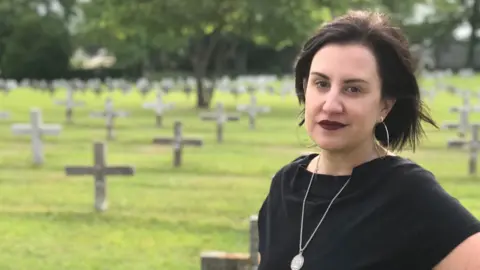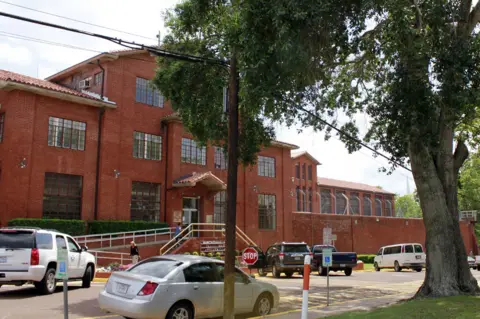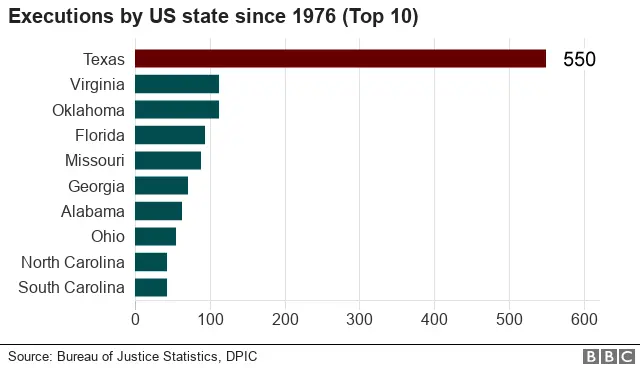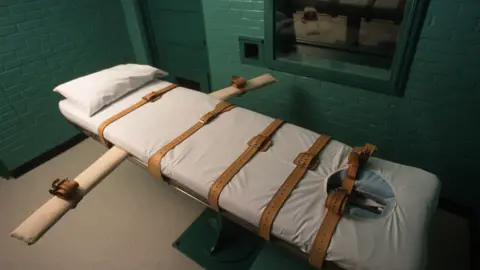The woman who watched 300 executions in Texas
 BBC News
BBC NewsTexas has executed far more people than any other US state, and one former employee of the state has watched hundreds of executions unfold. She speaks to Ben Dirs about the profound effect that had on her.
It is 18 years since Michelle Lyons watched Ricky McGinn die. But it still makes her cry.
When she least expects it, she'll see McGinn's mother, in her Sunday best, her hands pressed against the glass of the death chamber. Dressed to the nines to watch her son get executed. Some farewell party.
For 12 years - first as a newspaper reporter, then as a spokesperson for the Texas Department of Criminal Justice (TDCJ) - it was part of Lyons' job to witness every execution carried out by the state.
Between 2000 and 2012, Lyons saw almost 300 men and women die on the gurney, violent lives being brought to a peaceful conclusion, two needles trumping the damage done.
Lyons witnessed her first execution when she was 22. After seeing Javier Cruz die, she wrote in her journal: "I was completely fine with it. Am I supposed to be upset?"
She thought her sympathy was best set aside for more worthy causes, such as the two elderly men Cruz bludgeoned to death with a hammer.
"Witnessing executions was just part of my job," says Lyons, whose cathartic memoir, Death Row: The Final Minutes, which I collaborated on, has just been published.
"I was pro-death penalty, I thought it was the most appropriate punishment for certain crimes. And because I was young and bold, everything was black and white.
"If I had started exploring how the executions made me feel while I was seeing them, gave too much thought to the emotions that were in play, how would I have been able to go back into that room, month after month, year after year?"
Since 1924, every execution in the state has taken place in the small east Texas city of Huntsville. There are seven prisons in Huntsville, including the Walls Unit, an imposing Victorian building which houses the death chamber.
 Getty Images
Getty ImagesIn 1972, the Supreme Court suspended the death penalty on the grounds that it was a cruel and unusual punishment but within months some states were rewriting statutes to reinstate it.
Texas brought it back less than two years later and soon adopted lethal injection as its new means of execution. In 1982, Charlie Brooks was the first offender to be put to death by needles.
Crime makes Huntsville honest, and has earned it a reputation as the "capital punishment capital of the world". Certain journalists, usually from Europe, have written of the pervasive sense of death in the town, but they clearly arrived armed with an agenda.
Huntsville is a neat little place, set amid the beautiful Piney Woods, on the buckle of the Bible Belt. There are churches everywhere, the locals are polite, and you could spend a few days in the city without ever knowing it was where bad folk met their maker.
Whatever you imagine an execution witness to be like, Lyons isn't it. Over beers in Time Out Sports Bar - the sort of dive you might see on a documentary about a shooting in small-town America - Lyons speaks 19 to the dozen about any subject you fancy. Smart, cultured, and possessing a rapid-fire wit, she makes a mockery of that lazy British stereotype about Americans not doing irony. With Lyons, you bring your A game or get buried.
But when the conversation turns to the things she saw in the death chamber, sass gives way to vulnerability and it's not difficult to detect the toll it took.
In 2000, Texas carried out 40 executions, a record for the most in a single year by an individual state, and almost as many as the rest of United States combined.

Lyons, in her role as a prison reporter for The Huntsville Item, witnessed 38 of them. But her apparent nonchalance, which manifested itself in blithe entries in her journal, was merely a short-term coping mechanism.
"When I look at my execution notes now, I can see that things bothered me. But any misgivings I had, I shoved into a suitcase in my mind, which I kicked into a corner. It was the numbness that preserved me and kept me going."
Reading those early journal entries, it's the mundanities that jump out at you. Carl Heiselbetz Jr, who murdered a mother and her daughter, was still wearing his glasses on the gurney.
Betty Lou Beets, who buried husbands in her garden as if they were dead pets, had tiny little feet. Thomas Mason, who murdered his wife's mother and grandmother, looked like Lyons' grandfather.
"Watching the final moments of someone's life and their soul leaving their body never becomes mundane or normal. But Texas was executing offenders with such frequency that it had perfected it and removed the theatre."
That is not to say Lyons took her job lightly. And when she joined TDCJ's public information office in 2001, her duties became more onerous. Now, Lyons wasn't only telling the people of Huntsville, she was telling the rest of the United States - and the world - what went on in the Texas death chamber.
Lyons described the procedure as like watching someone going to sleep, which was a great disappointment to some victims' loved ones, who thought "Old Sparky" - the electric chair, by which 361 offenders were put to death between 1924 and 1964 - put on a better show than the less theatrical lethal injection.
 Getty Images
Getty ImagesBut she also had to relay the desperate pleas for forgiveness, the anguished apologies and outlandish claims of innocence, as well as Biblical passages, quotes from rock songs, even the occasional joke (in 2000, Billy Hughes went out with, "If I'm paying my debt to society, I am due a rebate and a refund"). Rarely did Lyons hear anger, and only once did she hear an inmate sobbing.
She heard the sounds of offenders' last breaths - a cough, or a gasp, or a rattle - as the drugs did their work and their lungs collapsed, pushing the air out like a set of bellows. And after the inmate had died, she watched them turn purple.
Lyons received letters and emails from all over the world, from people condemning her for taking part in "state sponsored murder". Sometimes she wrote back, angrily telling them to keep their noses out of Texas' business.
"Pretty much the whole world beyond America thought it was weird that we were still putting people to death. European journalists would often use the word 'killing' instead of 'executing'. They thought we were murdering people."
There were occasional circuses, such as when Gary Graham was put to death in 2000 and the world's media descended on Huntsville, along with Jesse Jackson, Bianca Jagger, the New Black Panthers, toting AK-47s, and the Ku Klux Klan, in full regalia.
Graham robbed 13 different victims in less than a week, pistol-whipped two of them, shot one in the neck and struck another with the car he was stealing from him. The final victim in his spree was kidnapped, robbed and raped.
None of this is disputed, because Graham pleaded guilty to the charges. However, he denied committing a murder at the start of his rampage. Lyons thought there were more deserving poster boys for the anti-death penalty movement.
 Getty Images
Getty ImagesBut sometimes, an offender's last moments were witnessed by a few prison staff and a sole journalist from the Associated Press.
As the drugs started flowing, there were no loved ones, either of the offender or his victims, to see him die. Even the local newspaper might not send a reporter. The state was carrying out the ultimate bureaucratic act on their doorstep and most of the citizens of Huntsville had no idea it was happening.
A condemned man or woman might be on death row for decades, so Lyons got to know some of them well, including serial killers, child murderers and rapists. Not all of them were monsters, and she came to like a few of them, and she even thought they might have been friends, had they met in the free world.
After Napoleon Beazley, who was only 17 when he murdered the father of a federal judge, was executed in 2002, Lyons cried all the way home.
"Not only did I get the sense that Napoleon wouldn't have been in any more trouble, I thought he could have been a productive member of society.
"I was rooting for him to win his appeals, but felt guilty about feeling that way. It was a heinous crime, and had I been the victim's family, I'd have absolutely wanted Napoleon to be executed. Did I have any right to feel sympathy for Napoleon, when Napoleon hadn't taken anything from me?"
But it was when Lyons became pregnant in 2004 that ambivalence began to set in and the mask began to slip.
"Executions ceased to be an abstract concept and became deeply personal. I started to worry that my baby could hear the inmates' last words, their pitiful apologies, their desperate claims of innocence, their sputtering and snoring.
"When I had my daughter, executions became things I dreaded. Usually, any emotion would come from the inmate's witness room, because while the victim's family had had a long time to process their loss, the inmate's family were watching a loved one die. They were just setting out on a long, hard road.
"I had a baby at home that I would do anything for, and these women were watching their babies die. I'd hear moms sobbing, yelling, pounding the glass, kicking the wall.
"I'd be standing in the witness room thinking: 'There are no winners, everybody is being screwed over'. Executions were just sad situations all round. And I had to witness all that sadness, over and over again."
Lyons soldiered on for another seven years, watching inmate after inmate walk to their death with an unsettling docility, until a bitter divorce from TDCJ, which resulted in her winning a case for gender discrimination. As well as heartbroken, Lyons felt lost, like a prisoner escaped after a lengthy sentence.
"I thought being away from the prison system would make me think about the things I'd seen less, but it was quite the opposite. I'd think about it all the time. It was like I'd taken the lid off Pandora's Box and I couldn't put it back on.
"I'd open a bag of chips and smell the death chamber, or something on the radio would remind me of a conversation I'd had with an inmate, hours before he was executed. Or I'd see the wrinkled hands of Ricky McGinn's mother, pressed against the glass of the death chamber, and I'd dissolve into tears."
There are signs that Texas is losing its appetite for the ultimate punishment. The last major poll in the state, in 2013, revealed that 74% of Texans supported the death penalty, so the death chamber is unlikely to be dismantled any time soon.
However, seven executions took place in Huntsville last year, the same as 2016 and a long way down from the record 40 in 2000.
But while Lyons believes Texas has employed the death penalty too often, she remains a supporter, at least for the worst of the worst. And Texas, as Lyons concedes, still does crime "bigger and crazier" than anywhere else in the US.
In the Joe Byrd Cemetery, a pretty plot of land where unclaimed Texas prisoners have been buried for more than 150 years, Lyons stands among the rows of crosses and wonders how many of these men she saw die. But it's not the executions she remembers that trouble her most, it's those she's forgotten.
"You don't see many flowers on the graves here," says Lyons. "And what does it say about me that I can't recall some of those men I saw executed? Maybe they deserve to be lonely and forgotten. Or maybe it's my job to remember."
Update 22nd May 2018: This article has been updated to clarify that Michelle Lyons' new book was written with Ben Dirs.
